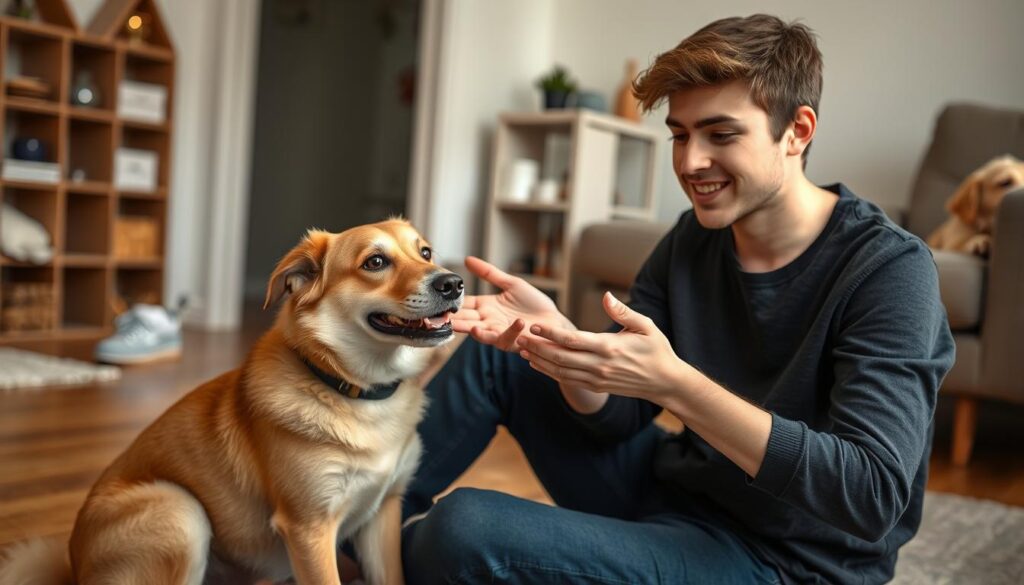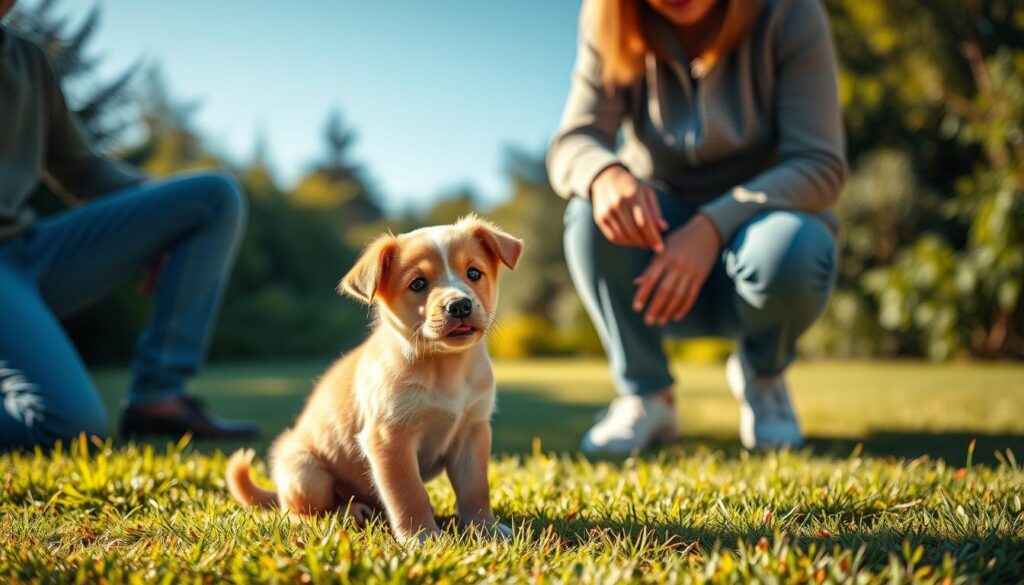As a dog owner, you want to give your pet the best start in life. Training is a big part of that. You might wonder when to start training your dog. The answer is, start as soon as you can. With the right tips, you can build a strong bond and help your dog behave well for life.

Knowing when to start training is key for your dog’s growth and your bond. Think about your dog’s age, breed, and how they develop. This helps you make a training plan that fits them perfectly. If you’re unsure when to start, this article will give you the insights and tips you need.
Introduction to Dog Training
With the right approach, your dog can become a well-behaved and loyal friend. In this article, we’ll dive into dog training. We’ll give you the knowledge and skills to succeed.
Key Takeaways
- Early training and socialization are crucial for your dog’s development
- Considering factors such as age, breed, and individual development is essential for creating a tailored training plan
- With the right dog training tips, you can create a strong bond with your pet
- Understanding when to start training your dog is vital for their development and your relationship with them
- When should I start training my dog? is a common question, and the answer is, the sooner, the better
- With patience, consistency, and positive reinforcement, you can help your dog become a well-behaved and loyal companion
The Critical Window for Puppy Training
As a dog owner, knowing the puppy training timeline is key. The critical window is when your puppy learns fast and forms habits for life. It’s split into three stages: basic development, prime learning, and building strong foundations.
From birth to 8 weeks, your puppy learns its environment and interacts with littermates. The prime learning period, from 8-16 weeks, is vital for socialization and training. It’s crucial to introduce your puppy to new people, places, and experiences during this time.
Between 16-24 weeks, your puppy builds strong foundations. This includes learning basic obedience commands and house training. It’s a critical time to bond with your puppy and teach them to follow commands. The obedience training age for dogs is usually between 16-24 weeks. Starting training early is essential for good habits and behaviors.

Key Stages in Puppy Development
- Birth to 8 weeks: Basic development and socialization with littermates
- 8-16 weeks: Prime learning period and socialization with new people and places
- 16-24 weeks: Building strong foundations, including basic obedience commands and house training
Understanding the puppy training timeline and obedience training age is vital. By following these stages and introducing your puppy to new experiences and training, you can help them become a well-behaved adult dog.
Why Early Training Matters for Your Dog’s Development
As a dog owner, you want the best for your pet. Training your dog early is key. It prevents behavior problems and builds a strong bond between you and your dog. Early training helps fix issues before they start, making your dog’s behavior better.
Training your dog early is vital for their growth. It teaches them important skills like socializing, house training, and basic commands. This helps avoid problems like anxiety, fear, and aggression. Training early makes your dog a well-adjusted, well-behaved family member.
Some key benefits of early training include:
- Improved socialization: Early training makes your dog confident and calm around new people and places.
- Reduced behavior issues: Early training prevents behavior problems from becoming serious.
- Stronger bond: Early training builds a strong, healthy relationship with your dog, based on trust and clear communication.

Understanding early training’s importance is crucial. It helps your dog become happy, healthy, and well-behaved. The best time to start training is as soon as possible. With patience, consistency, and positive reinforcement, your dog can overcome behavior issues and thrive.
Essential Skills to Teach During Different Growth Stages
As your dog grows, it’s key to teach them important skills. Puppy training milestones are crucial, and socialization for puppies is vital. Teach basic commands, house training, and social skills to make them confident and calm.
In the early stages, focus on socialization for puppies. This means exposing them to different people and animals. It helps them develop good social skills.
Some key skills to teach your dog include:
- Basic commands, such as “sit,” “stay,” and “come”
- House training milestones, including crate training and potty training
- Social skills development, including socialization with people and other animals
Teaching these skills helps your dog develop good habits and prevents accidents. It’s a key part of puppy training milestones. Always remember to prioritize socialization for puppies to make them confident and calm in new situations.
When Should I Start Training My Dog? Key Age Considerations
As a dog owner, you might wonder when to start training your dog. The right time depends on age, breed, and how your dog grows. Puppies can start training at 8 weeks, and adult dogs can start anytime. Think about your dog’s needs and abilities when deciding when should i start training my dog?.
Here are some age tips to remember:
- Puppies (8-16 weeks): Short, frequent training sessions are best for this age group.
- Adolescent dogs (4-12 months): More intense, focused training can begin at this stage.
- Adult dogs: Training can start at any time, and the approach will depend on the individual dog’s needs and abilities.
Every dog is unique, so dog training tips vary. Consider your dog’s age, breed, and growth to tailor a training plan. With patience, consistency, and positive reinforcement, your dog will become well-behaved and loyal.
Training your dog is a long-term commitment. Start early and stay consistent to help your dog develop good habits and a strong bond. Whether you’re wondering when should i start training my dog? or looking for dog training tips, be positive and patient.
Training Adult and Rescue Dogs
Training an adult or rescue dog is different from a puppy. They might have gaps in training or behavior issues. Professional dog training services can help fix these problems.
Creating a strong bond with your dog is key. Use positive reinforcement to reward good behavior. This builds trust and makes your dog understand what you want.
- Identifying and addressing previous training gaps to prevent confusion
- Implementing behavior modification strategies, such as positive reinforcement training
- Building trust and rapport through consistent, positive interactions
Training an adult or rescue dog takes patience and knowledge. Stay calm, consistent, and positive. If you need help, don’t hesitate to ask professional dog training services.
Positive Reinforcement Methods for Different Ages
Starting your puppy training journey? Focus on positive reinforcement. It encourages good habits and behaviors in your dog, no matter their age. Rewards and praise help build a strong training foundation and fix adult dog issues.
Consistency and patience are crucial in positive reinforcement training. Use clicker training or treats to motivate your dog. For instance, teach basic commands like “sit” or “stay” or fix problems like barking or chewing.
Positive reinforcement dog training has many benefits:
- Encourages good habits and behaviors
- Addresses existing behavioral issues in adult dogs
- Creates a strong foundation for future training
- Strengthens the bond between you and your dog
Positive reinforcement training sets your dog up for success. It builds a strong bond. Be patient, consistent, and positive. You’ll raise a well-behaved and well-adjusted dog.
Signs Your Dog is Ready for Advanced Training
As you move forward with obedience training, it’s key to know when your dog is ready for more. This is crucial for tackling behavior problems. Most dogs are ready for advanced training between 6 months to 1 year old.
Here are some signs your dog is ready for advanced training:
- They have more physical strength and agility for complex tasks.
- They show better mental focus and concentration.
- They have fewer behavior issues, like barking or chewing, and obey better.
When you see these signs, start introducing advanced training. Always reward good behavior and be patient with your dog as they learn.
By recognizing when your dog is ready for advanced training, you can help them become a well-behaved and loyal companion.
Common Training Challenges by Age Group
As you move through puppy training milestones, you’ll face different hurdles. It’s key to know these challenges to make a good training plan. Puppies often struggle with house training, socialization for puppies, and learning basic commands.
Here are some common training challenges by age:
- Puppies (8-16 weeks): house training, socialization, and basic obedience commands
- Adolescent dogs (4-12 months): refining obedience commands, addressing behavioral issues, and increasing physical activity
- Adult dogs: addressing existing behavioral issues, improving obedience, and increasing physical activity
By understanding these challenges and adjusting your training, you can help your dog succeed. Always be patient, consistent, and positive. Rewarding good behavior is important.
Professional Training vs. Home Training: Making the Right Choice
Choosing between professional and home training for your dog depends on several factors. Think about your lifestyle, your dog’s needs, and the kind of training you want. Each option has its own pros and cons.
Professional dog training gives your dog personalized attention and expert guidance. It’s great for puppies or dogs with behavioral problems. Home training, on the other hand, is flexible and convenient. You can train your dog in your own home with the right tips.
- Cost: Professional training might cost more than home training.
- Time commitment: Home training needs a lot of time from you.
- Expertise: Professional trainers are skilled in handling tough training issues.
By looking at these points and thinking about your dog’s needs, you can choose the best option. Whether it’s professional dog training services or home training, it’s about what’s best for you and your dog.
Creating an Age-Appropriate Training Schedule
Starting your dog’s training is exciting. It’s key to make a schedule that fits their needs and skills. A good puppy training timeline keeps you on track. It helps your dog learn important skills and behaviors.
When picking the right obedience training age for dogs, think about their breed, size, and personality. Puppies can learn basic commands from 8 weeks old. Adult dogs might need more complex training. A custom training plan helps solve specific problems and strengthens your bond.
- How often and long to train
- The type of training (e.g., obedience, agility, socialization)
- How to reward them (e.g., positive reinforcement, clicker training)
- Increasing the difficulty and complexity slowly
Following a structured training plan and adjusting it for your dog’s needs is crucial. It helps them reach their best and builds a strong bond. Be ready to change the plan as needed for the best results.
Conclusion: Setting Your Dog Up for Lifelong Success
Starting your dog’s training is a journey that lasts a lifetime. It needs patience, dedication, and a willingness to meet your dog’s needs. By understanding early training, knowing when to move to advanced training, and planning a schedule, you can help your dog succeed.
Every dog is unique, and what works for one might not work for another. Be flexible, get help when you need it, and use positive reinforcement. This way, your dog will be well-behaved and loyal, and your bond will grow stronger.
With the right training and a commitment to your dog’s growth, they will become confident and well-adjusted. They will make your life richer for years to come. Enjoy the journey, celebrate your dog’s progress, and cherish the rewards of a well-trained pet.
FAQ
When should I start training my dog?
The right time to start training your dog varies. It depends on their age, breed, and how they develop. Puppies can start training at 8 weeks old. Adult dogs can start anytime. But, you must consider your dog’s needs and abilities when planning their training.
What are the key age considerations for dog training?
Puppy training is most important during their first few months. This is when they learn important skills and habits. From birth to 8 weeks, puppies go through basic development.
The period from 8-16 weeks is key for socialization and training. From 16-24 weeks, they build strong foundations, like basic commands and house training.
Why is early training important for my dog’s development?
Early training is crucial for your dog’s growth. It prevents behavior problems and builds a strong bond with you. Starting early helps correct bad behaviors and reinforces good ones.
It also teaches them essential skills like socialization, house training, and basic commands.
What essential skills should I teach my dog during different growth stages?
As your dog grows, teaching them important skills is vital. Basic commands like “sit,” “stay,” and “come” are essential. House training, including crate and potty training, helps them develop good habits.
Social skills, like getting along with people and other animals, are also crucial. They help your dog feel confident and calm in new situations.
How can I use positive reinforcement methods for training dogs of different ages?
Positive reinforcement works well for dogs of all ages. It focuses on rewards and praise, not punishment. This method is especially important for puppies, helping them build a strong foundation.
For adult dogs, it can help with existing behavior issues and improve obedience.
How do I know when my dog is ready for advanced training?
Knowing when your dog is ready for advanced training is important. Look for physical signs like increased strength and agility. Mental maturity, like better focus and concentration, is also key.
Behavioral signs, like improved obedience and fewer unwanted behaviors, show they’re ready for more challenging tasks.
What are some common training challenges I may face with my dog at different ages?
Different ages bring unique training challenges. Puppies face house training, socialization, and basic commands. Adult dogs may need to work on existing behaviors, improve obedience, and get more exercise.
Understanding these challenges helps you tailor your training plan. This way, you can help your dog overcome obstacles and reach their full potential.
Should I choose professional training or home training for my dog?
You have two main options for training your dog: professional or home training. Professional training offers personalized attention and expert guidance. It also helps with socialization.
DIY training is flexible and convenient, allowing you to train at home. Hybrid training combines the best of both worlds, offering a balanced approach.
